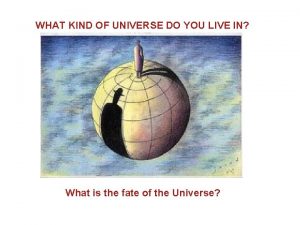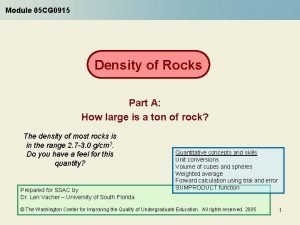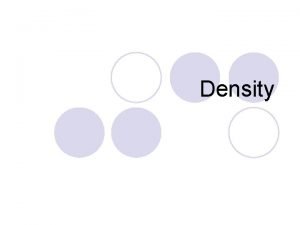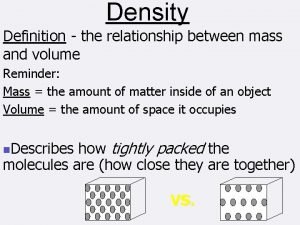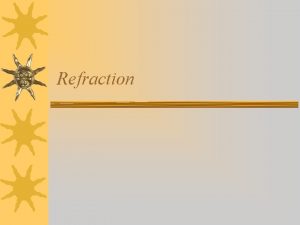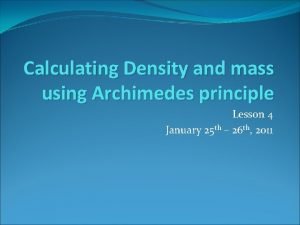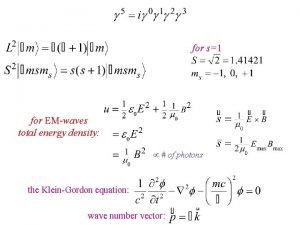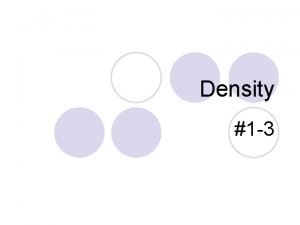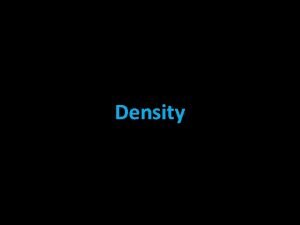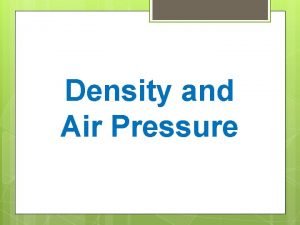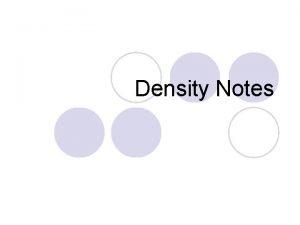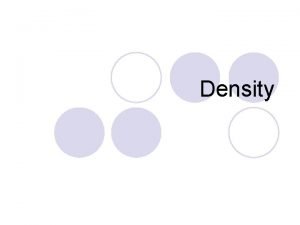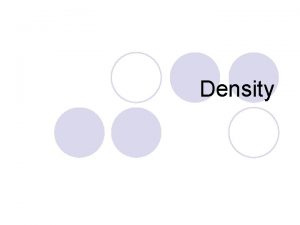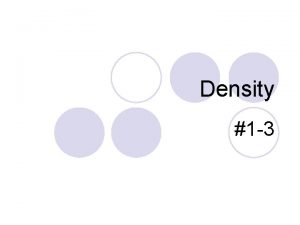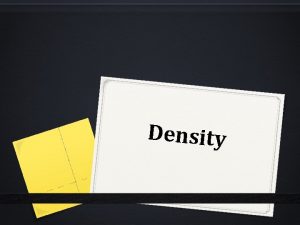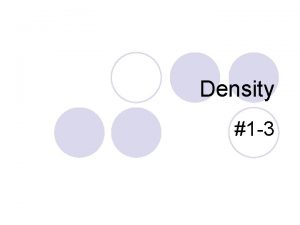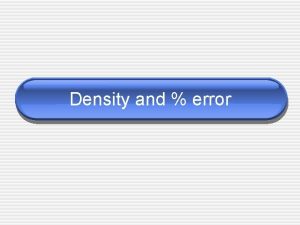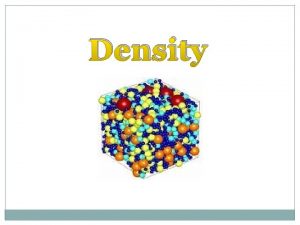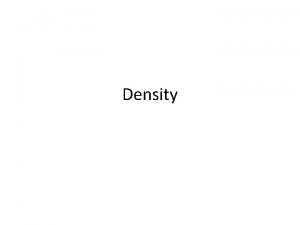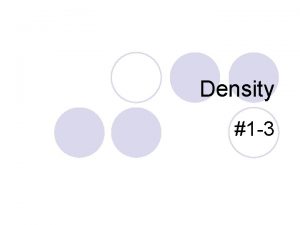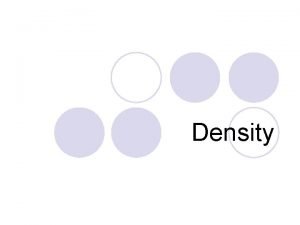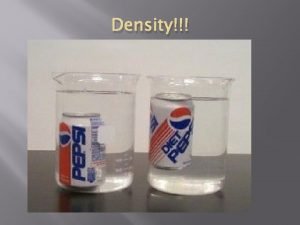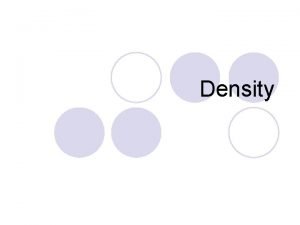Density What is density l Density is a




















- Slides: 20

Density

What is density? l Density is a comparison of how much matter there is in a certain amount of space.

Which one is more dense? l Demonstration: People in a square l How about this: Which square is more dense?

Which one is more dense? l Now which one is more dense?

What is density? l Density = mass OR volume mass ÷ volume. l Units for density: g cm 3 l Why are these the units for density? ALWAYS. REMEMBER UNITS!

Let’s try a density problem together l Frank has a paper clip. It has a mass of 9 g and a volume of 3 cm 3. What is its density? l Frank also has an eraser. It has a mass of 3 g, and a volume of 1 cm 3. What is its density?

Work on these problems with your neighbor. l Jack has a rock. The rock has a mass of 6 g and a volume of 3 cm 3. What is the density of the rock? l Jill has a gel pen. The gel pen has a mass of 8 g and a volume of 2 cm 3. What is the density of the pen?

Now, try these on your own. l Alicia has a watch. It has a mass of 4 g and a volume of 2 cm 3. What is the density of the watch? l Mia has a wallet. It has a mass of 15 g and a volume of 5 cm 3. What is the density of the wallet?

Liquid Layers l If you pour together liquids that don’t mix and have different densities, they will form liquid layers. l The liquid with the highest density will be on the bottom. l The liquid with the lowest density will be on the top.

Liquid Layers l Check out this picture from your book. Which layer has the highest density? l Which layer has the lowest density? l Imagine that the liquids have the following densities: ¡ 10 g/cm 3. ¡ 6 g/cm 3. 3 g/cm 3. 5 g/cm 3. l Which number would go with which layer?

Liquid Layers – Try with your neighbor l Which liquid has the highest density? l Which liquid has the lowest density? l Which liquid has the middle density?

Liquid Layers – Try on your own! l Imagine that the liquids on the right have the following densities: ¡ 15 g/cm 3 ¡ 3 g/cm 3 ¡ 7 g/cm 3 10 g/cm 3 9 g/cm 3 12 g/cm 3 l Match the colors to the correct densities. 3 g/cm 3 7 g/cm 3 9 g/cm 3 10 g/cm 3 12 g/cm 3 15 g/cm 3

Review l What is the formula for density? l What happens if you pour together liquids that have different densities? l Will the liquid on the top have the highest or lowest density? l Will the liquid on the bottom have the highest or lowest density?

Super Scientist Question of the Day l Jake has a book, a ruler, and a balance. l How can Jake find the density of the book with the tools he has?

PG. 2 ON DENSITY Practice A: Volume (L x W x H) a. An object has a length of 3 cm, a width of 2 cm, and a height of 4 cm. Calculate volume. 3 cm x 2 cm x 4 cm = 24 cm 3 b. A cube has sides that measure 5 cm. Calculate volume. 5 cm x 5 cm = 125 cm 3

Continued… Practice B: Density (Density = mass/volume) c. A cube measures 2 cm on each side and has a mass of 16 g. Calculate density. D= 16 g 2 x 2 cm 16/8 = 2 g/cm 3


Continued… l Practice c: Density in water ¡Water has density of 1 g/cm 3 ¡Density > Water = sink ¡Density < Water = float d. Will the object in question (e) sink or float in water? SINK 2>1

Density Vocab l Mass – amount of matter that makes up a substance l Volume – amount of space an object takes up ¡(L x W x H) - regularly shaped solid ¡water displacement - irregular solids l(water before object – water after object) l. Find the difference using a graduated cylinder

Density ¡Water has density of 1 g/cm 3 ¡Density > Water = sink ¡Density < Water = float
 Sp gravity
Sp gravity Nda full dac
Nda full dac Linear density of fcc
Linear density of fcc Physiological population density
Physiological population density What does arithmetic density tell us
What does arithmetic density tell us Linear density and planar density
Linear density and planar density Warm air aloft is normally associated with
Warm air aloft is normally associated with Critical density
Critical density Granite density
Granite density Is oil more dense than water
Is oil more dense than water Definition of mass and volume
Definition of mass and volume Chapter 14 interactions in ecosystems
Chapter 14 interactions in ecosystems Density dependent limiting factors
Density dependent limiting factors Density and speed
Density and speed Density of sea water
Density of sea water Bulk density
Bulk density Calculate density using archimedes principle
Calculate density using archimedes principle Energy density formula
Energy density formula Apparent density
Apparent density Optical density in radiography
Optical density in radiography Density estimation trees
Density estimation trees







